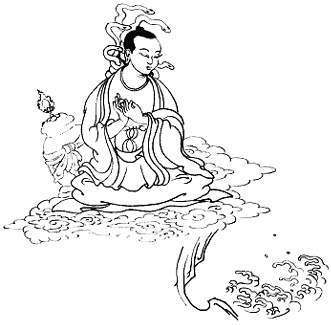NAGARJUNA


The Madhyamika school traces its origin to Nagarjuna, the brilliant philosopher and formidable dialectician who flourished in the late second century A.D. Taking Buddha's advocacy of the Middle Way between harmful extremes, between avid indulgence and austere asceticism, and between sterile intellectualization and suffocating mental torpor, Nagarjuna developed a rigorous dialectical logic by which he reduced every philosophical standpoint to an explosive set of contradictions. This did not lead to the closure of scepticism, as the less vigorously pursued pre-Socratic philosophies did, but rather to the elusive standpoint that neither existence nor non-existence can be asserted of the world and of everything in it. The Madhyamikas, therefore, refused to affirm or deny any philosophical proposition. Nagarjuna sought to liberate the mind from its tendencies to cling to tidy or clever formulations of truth, because any truth short of Sunyata, the voidness of reality, is inherently misleading. Relative truths are not like pieces of a puzzle, each of which incrementally adds to the complete design. They are plausible distortions of the truth and can seriously mislead the aspirant. They cannot be lightly or wholly repudiated, however, for they are all the seeker has, and so he must learn to use them as aids whilst remembering that they are neither accurate nor complete in themselves.
By the fifth century two views of Nagarjuna's work had emerged. The followers of Bhavaviveka thought that Madhyamika philosophy had a positive content, whilst those who subscribed to Buddhapalita's more severe interpretation said that every standpoint, including their own, could be reduced to absurdity, which fact alone, far more than any positively asserted doctrine, could lead to intuitive insight (prajna) and Enlightenment. Chandrakirti's remarkable defence of this latter standpoint deeply influenced Tibetan Buddhist traditions as well as those schools of thought that eventually culminated in Japan in Zen. Nagarjuna's dialectic revealed the Sunya or emptiness of all discursive, worldly thought and its proliferating categories. For the Madhyamikas:
Whatever can be conceptualized is therefore relative, and whatever is relative is Sunya, empty. Since absolute inconceivable truth is also Sunya, Sunyata or the void is shared by both Samsara and Nirvana. Ultimately, Nirvana truly realized is Samsara properly understood. The fully realized Bodhisattva, the enlightened Buddha who renounces the Dharmakaya vesture to remain at the service of suffering beings, recognizes this radical transcendental equivalence. The Arhat and the Pratyekabuddha, who look to their own redemption and realization, are elevated beyond any conventional description, but nonetheless do not fully realize or freely embody this highest truth.
Thus for the Madhyamikas, the Bodhisattva ideal is the supreme wisdom, showing the unqualified unity of unfettered metaphysics and transcendent ethics, theoria and praxis, at the highest conceivable level.
Madhyamika thought rooted itself in the remarkable collection of Mahayana sutras known as the Prajnaparamita (or perfection of wisdom) literature. These sutras, from the one hundred thousand verses of Shatasahasrika Prajnaparamita to the terse Heart Sutra and the short Vajrachchedika (literally, 'Diamond Cutter', but commonly called Diamond Sutra), share the same themes skilfully expounded at different lengths. According to these sutras, all dharmas or elements of existence are Sunyata or void. Although many human beings are terrified of voidness, as is shown by the instinctive dread of the dark and the unknown, this arises from a basic misunderstanding of Sunyata. It is unchanging, deathless, unqualified reality. If one understands Sunyata-sunyata, the Voidness of the Void, one recognizes that it is not any 'nothing' one knows or can imagine. Being truly unknown, there is no sufficient reason to dread it. Rather than entertain vague, ill-conceived and inchoate images of the imageless, one would do better to practise the paramitas, the dynamic virtues of the Noble Eightfold Path leading to the inestimable glory which the ignorant world calls Sunyata solely because it is beyond its ken. The Bodhisattva, however, sees the plenitude of that Void as well as the emptiness of the phenomenal world, and so he labours in joy for the redemption of those who suffer from abject ignorance.
As a matter of interest, the above mentioned 'Diamond Cutter Sutra' is the same sutra that the Sixth Patriarch of Chinese Zen, Hui-neng (638-713), did nothing but just overhear a stanza from as a young boy and was Enlightened to the Truth of the masters basically out of the blue.
There are some that say Nagarjuna, whose dates are usually given to fall within those of the Han Dynasty, visted China, although evidence is scarce. Kumarajiva (344-413) who arrived in China well after the Han Dynasty, started his translation projects around 385-401. He is considered the key figure in the introduction of Nagarjuna's teachings into China.
For information regarding Buddhism and Zen in later dynasties: T'ANG DYNASTY (618-907), SUNG DYNASTY (960-1279), and the MING DYNASTY (1368-1644), click HERE.
NAGARJUNA'S CONCEPT OF TIME
HUI SHEN: BHIKSHU
Fundamentally, our experience as experienced is not different from the Zen master's. Where
we differ is that we place a fog, a particular kind of conceptual overlay onto that experience
and then make an emotional investment in that overlay, taking it to be "real" in and of itself.
(PLEASE CLICK)
ZEN ENLIGHTENMENT IN A NUTSHELL
CLICK
HERE FOR
ENLIGHTENMENT
ON THE RAZOR'S
EDGE
MAJOR HISTORICAL BUDDHIST MASTERS, ZEN ANCESTORS AND ZEN PATRIARCHS
Bodhidharma, Hui'ko, Hui Shen, Hui Neng, Shih-t'ou Hsi-ch'ien, Zhaozhou, Moshan Liaoran,
Mugai Nyodai, Nagarjuna, Ganapati Muni, Kuan Yin, Tung-Shan, Te Shan, Dogen